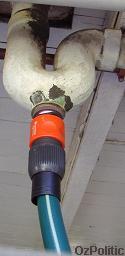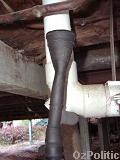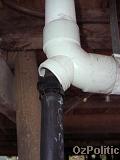
WaterView list of forum discussions about the water crisis.UPDATE: The sodium in many soaps is bad for clay soils. Not as salt (NaCl), but in other forms. Apparently, it binds chemically to clay particles in preference to nutrients, which allows nutrients to leach out of the soil. This can be reversed with calcium and organic matter. Stay tuned for more info on this. I have heard one account of a person damaging the soil in a small veggie patch by putting all of their washing up liquid on it. It reduced the water holding capacity of the soil. In the meantime, try to only use shower water and look for sodium free soap. There is a water shortage in most capital cities, however this is mainly because we waste so much. We flush our toilets and wash our clothes in drinking water that has been sanitised at huge cost. We send a lot of water down the drain to mix with sewage when it can be used on the garden. People often get put off because they assume you have to spend hundreds or thousands of dollars on greywater systems or tanks. This is not the case and twenty dollars should get you a long way, if your house is raised. I divert shower water onto the garden and fruit trees and have not had any problems with soap. I have not bothered to get environmentally friendly soap. I also divert a lot of the roof runoff straight onto the ground without storage. It used to be illegal to use greywater, just as it used to be illegal to have a rainwater tank. But the drought has forced our politicians to quietly remove all these obstacles to avoid embarrassment. Do’s and dont’s: If you are using untreated greywater, do not put it all in the same spot. It is not allowed to pool or become smelly. Move the hose after each shower. Do not use kitchen sink water – I think the fats and oils are bad. Unless you use special laundry detergent, do not use the first batch of laundry water, but the rinse cycle water should be OK. Laundry water has the advantage that it is pumped out by the washing machine and may be a good option for low houses on flat ground.
Use thick (3/4 inch) garden hose or pipe rather than standard half inch garden hose, or something even thicker. The standard size garden hose will not let the water flow through fast enough.
GreywaterGreywater, sometimes spelled graywater, grey water or gray water and also known as sullage, is non-industrial wastewater generated from domestic processes such as washing dishes, laundry and bathing. Greywater comprises 50-80% of residential wastewater. Greywater is distinct from blackwater in the amount and composition of its chemical and biological contaminants (from feces or toxic chemicals). Greywater gets its name from its cloudy appearance and from its status as being neither fresh (white water from groundwater or potable water), nor heavily polluted (blackwater). According to this definition greywater may exclude wastewater containing significant food residues or high concentrations of toxic chemicals from household cleaners etc.In recent years concerns over dwindling reserves of groundwater and overloaded or costly sewage treatment plants has generated much interest in the reuse or recycling of greywater, both domestically and for use in commercial irrigation. However, concerns over potential health and environmental risks means that many jurisdictions demand such intensive treatment systems for greywater that the commercial cost is higher than for fresh water. Despite these obstacles, greywater is often reused for irrigation, illegally or not, in drought zones or areas hit by hose pipe bans, typically by manual bucketting. In the third world, reuse of greywater is often unregulated and is common. At present, the recycling of greywater is poorly understood compared with elimination.
Elimination of greywaterDomestic wastewater plumbing is usually combined at the sewer, so that grey and black waters are removed together using a shared sewerage system. Sewage water can then be treated to limit pollution and health risks, before being returned to the environment at large. The majority of greywater ends up as effluent in rivers and oceans in this way.
Recycling of greywaterMost greywaters are much easier to treat and recycle than blackwaters, due to their lower levels of contamination. However, entirely untreated greywater is still considered to be a potential health and pollution hazard.If collected using a separate plumbing system to blackwater, domestic greywater can be recycled directly within the home and garden. Recycled greywater of this kind is never clean enough to drink, but a number of stages of filtration and microbial digestion can be used to provide water for washing or flushing toilets; relatively clean greywater may be applied directly from the sink to the garden, as it receives high level treatment from soil and plant roots. Given that greywater may contain nutrients (e.g. from food), pathogens (e.g. from your skin), and is often discharged warm, it is very important not to store it before using it for irrigation purposes, unless it is treated first. There are numerous "soft" processes based on natural biological principles such as using reedbed filter systems, the wetpark systems or the living wall that can be used to clean up greywater. There are also "hard", direct processes, such as distillation (evaporation) which need not necessarily be as energy intensive as they might initially appear. There seem to be no commercially available "hard" greywater recovery devices suitable for on-site use in the individual household, even though a number of such technologies exist.. Some municipal sewerage systems recycle a certain amount of grey and black waters using a high standard of treatment, thus providing reclaimed water for irrigation and other uses.
Application of recycled greywater
Irrigation However, long term research on greywater use on soil has not yet been done and it is possible that there may be negative impacts on soil productivity. If you are concerned about this, avoid using laundry powders; these often contain high levels of salt as a bulking agent, and this has the same effect on your soil as a drought.
Domestic use The level of treatment required in this case requires the water to have low or nil biochemical oxygen demand (BOD), but it is not necessary for it to be treated to the same standards as potable water. Greywater recycling for toilet flushing is currently considered to be uneconomical or environmentally unfriendly at most domestic levels. However, a Quebec company, Brac Systems, has recently patented a cost-effective system that uses a chlorine treatment, and is selling the system in the Americas, Europe, and Australia.
Extreme living conditions
Heat reclamation
Greywater and the environmentThe potential ecological benefits of greywater recycling include:
Move towards Ecologically Sustainable DevelopmentBecause greywater use, especially domestically, reduces demand on conventional water supplies and pressure on sewage treatment systems, its use is very beneficial. In times of drought, especially in urban areas, greywater use on gardens or in toilet systems helps to achieve Ecologically Sustainable Development by helping to meet its principles.
Dangers associated with Greywater useWhen treated properly, greywater is of sufficient quality to use on gardens and landscapes but it is important to remember that greywater contains impurites and microorganisms that are capable of causing disease and illness. A recent study carried out by the Queensland Department of Natural Resources, Mines and Energy covering the quality of domestic greywater found that greywater has organic strength and harmful organisms equal to and in some instances greater than toilet waste. Many substances used for cleaning and washing are designed to be treated in a sewage treatment plant. The term "biodegradable" means the product is able to be degrade in a wastewater treatment plant where the established bacterial community will quickly metabolise these compounds. However, such substances will still degrade elsewhere, but the timeframe may be longer. Laundry wastewater can contain harmful organisms such as E.coli and diseases such as Hepatitis, which can remain in the correct ground conditions for extended periods of time. In general, it is difficult for human pathogens to remain viable for long periods in the soil, owing to the existing competitive bacterial community. Uncontrolled release of greywater, with its associated nutrient load, could find its way into storm water drainage systems and streams causing algal blooms and disruption of ecosystems. Importantly, sensible precautions can mitigate almost entirely the risk associated with greywater use. In order for disease transmission, people have to contact (by aerosol or directly) the greywater. If the greywater is applied by dripper systems or by subsurface delivery, this cannot occur. Avoiding greywater use, particularly by spraying, on vegetables eaten raw is recommended.
Tips on how to minimise health risks associated with greywater
|


